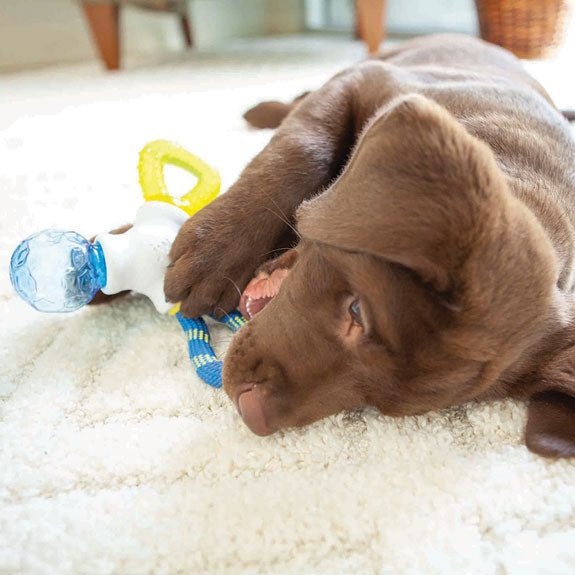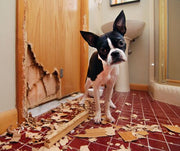Puppy Teething Guide: What to Expect and How to Manage the Pain

Puppy teething can prove to be intense, and it raises a lot of questions in pet-parents minds – When do puppies start teething? How do I know when my puppy starts teething? Can I do anything about it?
Surviving the puppy teething phase is nothing less than a challenge! But, if you know what to do and when to expect it, you can definitely get a step ahead and save your shoes, furniture, or clothes from nipping!
Teething is an experience that you share along with you pup. You're going to feel and see their discomfort and go through it with them. The best way to approach this often uncomfortable process is to know everything about it ahead of time so that you're as prepared as possible.
WHEN DOES TEETHING BEGIN?
Dogs, much like humans, develop two sets of teeth in their lifetime. The first set of teeth are obviously called the milk teeth, usually acting as placeholders for permanent teeth. They are succeeded by permanent teeth, which can take up to two years to set according to the jaw, making teething behavior quite normal up until about two years of age.
Usually when puppies are between five or six weeks (much younger than humans) old, puppies start getting their milk teeth. Once they reach 12-16 weeks of age, the milk teeth begin falling out – being replaced by the permanent set of teeth.
Around the time puppies are six months old, most puppies have lost all of their milk teeth. At around 8 months old, their permanent set of teeth are fully grown in. It's important to note that six months of age is an appropriate time to check your puppy's mouth to make sure the milk teeth are gone and the permanent teeth are coming in straight, un-cracked, and unbroken.
SYMPTOMS OF PUPPY TEETHING
You are well aware that teething is more than just an uncomfortable experience for your puppy. There are some changes that you may take note of in your puppy's behavior or appearance that can indicate their discomfort level:
- Irritated, red gums
- More chewing
- Drooling
- Blood on toys after chewing
Even though these symptoms might make you feel uncomfortable and appear unsightly, they are quire normal symptoms. Unless your pup is in extreme pain, you've got nothing to worry about! You can always check in with your vet for any concerns or questions.
HOW TO HELP YOUR PUPPY EASE TEETHING PAIN
Even though teething is a painful process for your puppy, the good news is that there are a lot of things you can do to help ease the pain! Have you noticed a lot of increasing chewing from your puppy? Well that's because chewing is a way for puppies to relieve the pain teething can cause.
You will need to give your puppy a productive and safe chewing outlet to help him manage the pain and ensure they don't chew up everything in the house!
Here are some tried and tested ways to help your puppy during teething:
- Frozen Treats: A popsicle is a perfect example of the kind of frozen treats you can give your puppy to help relieve the pain. Try freezing some dog-friendly veggies or fruits with water in an ice tray then give it to your pup! These help soothe pain and inflammation, proves to be a yummy treat, and keeps them busy!
- Frozen Rags: Try running a rag under cold water until its soaked. Then ring it out and place the wet rag in the freezer for a couple of hours. The coldness from the rag will numb your puppy's gums, which helps relieve teething discomfort.
- Teething Toys: Teething toys are quite popular, and often a lifesaver for those with a puppy in the house. They are specifically made for puppies in the teething phase and are durable enough to withstand all of the gnawing and chewing from sharp puppy teeth

The JW Puppy Connects (shown above) is a great puppy toy that gives puppies 4 different chewing textures to choose from and can be replaced if your puppy wears them out. Another great puppy chew toy option is the JW Snail Teether (shown below). This chew toy is made out of non-toxic, puppy-safe rubber and has knobs all over it that gently massages your puppy's gums as they chew. It's a real teether made just for puppies.

HOW TO REDUCE PUPPY NIPPING AND BITING?
While chewing seems to be a natural behavior for your puppy, nipping and biting is a little different. If your puppy nips your ankles or sometimes bites during play – that's normal! But if this behavior continues as he/she grows older, then you need to address it. Use this guide to find out if your dog is roughhousing around too aggressive.
What can you do to control this? Here are some tips:
- Puppy proofing your house should be the first step. Even though your main goal is correcting the biting behavior, discouraging him from chewing everything in sight is a place to start. This will also help to limit the damage of training slip-ups.
- A lot of canine behavior problems stem from the lack of physical and mental exercise. So, make sure your puppy get plenty of exercise! Usually, any puppy requires 30 minutes of playtime or exercise to let go of the pent up energy, which helps to prevent biting.
- Training sessions are the most obvious solution to reducing biting and nipping behavior. You can use some high value treats and practice with words like "sit", "stay", or "leave it" to help strengthen your puppy's impulse control.
- You can also try and redirect your puppy's chewing or biting habits with some positive alternatives – like long-lasting dog treats!
Teething is a rough stage for everyone. Your puppy experiences pain and discomfort while you deal with the fallout. Your main goal with your puppy during the teething phase should be to make it as comfortable for them as possible. With the right toys, treats, and a dash of TLC, your puppy will be through the teething phase in no time at all.
Previous article

Next article

Related posts
View all-

How to Keep Your Pet Calm During Thanksgiving
Thanksgiving is a time for family, friends, and food, but for our pets, the holiday can be overwhelming. The sudden change in routine, unfamiliar faces and scents, and increased noise can trigger significant stress. Understanding why your pet might feel anxious is the first step toward creating a peaceful holiday experience for everyone, including your furry family members. This guide offers calming tips for pets and practical solutions to ensure your dog or cat feels safe and secure during the festivities.
Read Article -

Top Travel Essentials for Pets This Holiday Season
Holiday travel often means bringing the whole family along, and for many of us, that includes our furry companions. Preparing for holiday pet travel is about more than just packing a bag; it's about ensuring your pet's safety, comfort, and happiness from the moment you leave home until you return. A little planning helps reduce stress for both you and your pet, making the journey a positive experience for everyone involved.
Read Article -

Best Leashes and Collars for Daily Walks: A Pet Parent’s Guide
A daily walk with your dog isn't just a chore—it's a chance to bond, explore, and stay active together. The right leash and collar can make every walk safer and more enjoyable for both of you. With numerous styles and materials available, it's essential to find gear that suits your dog's needs and your lifestyle.
Read Article



